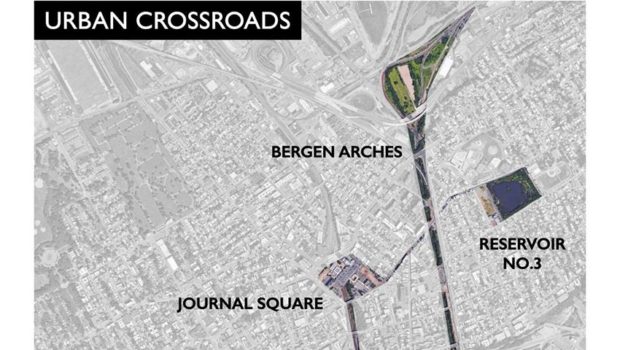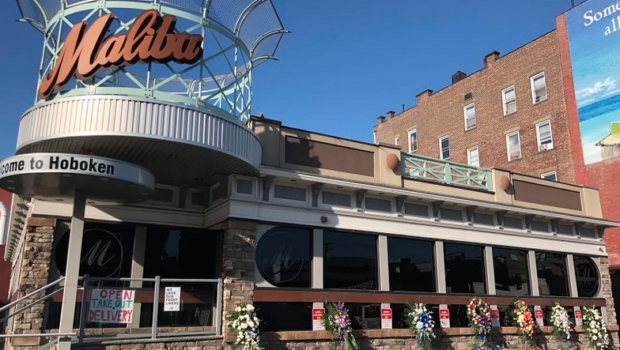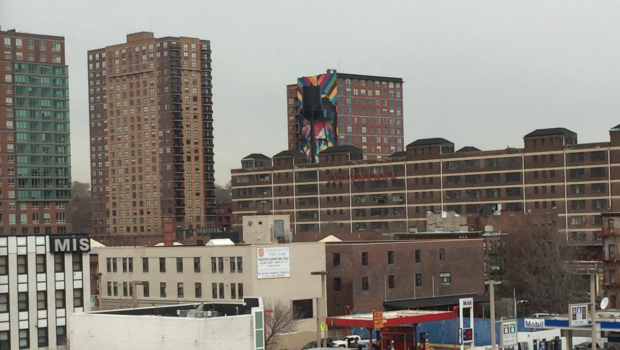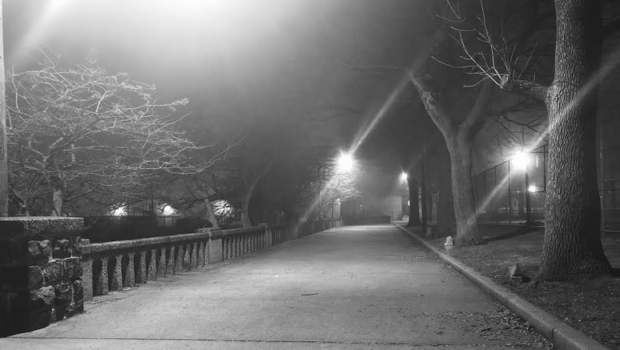
URBAN CROSSROADS: Jersey City Arts Council Explores Opportunities for Re-imagined Ecological Infrastructure
Jersey City is pretty big.
So big, in fact, that significant portions of the city—directly across the Hudson from Manhattan and currently emerging as one of the most dynamic real estate markets in the nation—sit untouched for decades, rendered inaccessible by current design and essentially reclaimed by nature.
“Across the nation, abandoned infrastructure elements are the monumental, sociological and ecological wounds of our industrial past,” says architect Joe Berlinghieri, Chairman of the Jersey City Art Council’s Architecture & Design Committee. “Much of it was constructed at a time when urban planning didn’t exist. As much as it connected the nation, more often than not it divided communities. Like any wounds, Jersey City’s must heal and in the process reconnect the communities they divide.”
The council is currently hosting an exhibit titled Urban Crossroads: Hidden Gems/Reservoir and Bergen Arches at Hudson County Community College’s Dineen Hull Gallery (71 Sip Avenue, 6th Floor).
The exhibition presents the collaborative research of New Jersey Institute of Technology’s College of Architecture and Design, Rutgers University’s Master of Landscape Architecture, the Jersey City Arts Council’s Architecture and Design Committee, and the newly formed Bergen Arches Preservation Coalition—showcasing the potential for Jersey City to re-imagine its infrastructural past as an un-interrupted public and ecological corridor within the heart of its urban fabric.
Te exhibit depicts how a floating natural forest and a forgotten ravine could link together to become a public asset that rivals New York City’s Highline and Lowline and connects Jersey City to the United States East Coast Greenway.

“It’s essential to seize this opportunity precisely because this opportunity is not limited to the boundaries of Jersey City, and we have an opportunity to be a thought leader on a topic that is forefront in the minds of huge swaths of the country,” Austin Sakong, Commissioner on the Jersey City Historic Preservation Commission. “The national conversation about infrastructure is astoundingly impoverished. We still talk about roads and bridges, it’s as if we’re still in (Robert) Moses era. We have an opportunity to help expand the public’s understanding of what constitutes infrastructure in the built environment– whether it’s ecological infrastructure, social infrastructure, political infrastructure. And in so doing, we have an opportunity to change the ways in which we think about the public sphere, what constitutes public services, and what roles engaged community members play in this opportunity.”
The Jersey City Arts Council presents an engaging panel discussion to close out the exhibition on Thursday, April 18, from 6-8 p.m.
“While the students from NJIT and Rutgers have made some incredibly thoughtful proposals involving expanded public transportation, public recreation, cultural assets, and storm resilience among others,” says Berlinghieri, “the goal of the exhibit is primarily to raise awareness of these conditions, foster a wider understanding of our reclaimed ecology, elevate the discussion of our larger planning issues, and encourage increased involvement by Jersey City’s citizens.”
Panelists for the event include:
- Tricia Martin, Landscape Architect at SCAPE
- Sean Gallagher, Director of Sustainable Design at Diller Scofidio + Renfro
- Matthew McMahon, Landscape Architect, Project Manager at Snøhetta
- Luke Schray, Board Member of the Embankment Preservation Coalition
The areas highlighted in the discussion are under constant pressure for increased development.
“Development is not the one size fits all solution to planning that people think it is. In truth it is only part of the answer. Carefully located developments should be considered as part of any urban planning solution. They can relieve pressure on our housing shortage, provide sites for new schools and expand our tax base. All these things should be included in some way,” says Berlinghieri. “But our school and public transportation systems are already dangerously overcrowded. Jersey City needs a solution that alleviates those problems instead of exacerbating them. The scale and dispersion of these abandoned infrastructure elements provide Jersey City with an opportunity to reimagine itself as a something new, a city where urban and natural conditions are interwoven symbiotically in a way that fosters sustainability, public health and connectivity. ”
Sakong adds, “the important thing is not who makes the decision, but what forms of accountability the decision makers have to the public—whether they are federal agencies, local politicians, private land owners, or intrastate authorities (and more often than not, it’s a mix of several or all of the above).”
CLICK HERE for more information and tickets to the discussion.

***

 Previous Article
Previous Article Next Article
Next Article Konstantinos Babalis, Longtime Malibu Diner Owner, Has Passed Away
Konstantinos Babalis, Longtime Malibu Diner Owner, Has Passed Away  Top Producers Lori Staselis and Ann Wycherley Join Halstead New Jersey; Company to Join Forces with Brown Harris Stevens
Top Producers Lori Staselis and Ann Wycherley Join Halstead New Jersey; Company to Join Forces with Brown Harris Stevens  hOMES: Weekly Insight Into Hoboken & Jersey City Real Estate Trends | June 28, 2021
hOMES: Weekly Insight Into Hoboken & Jersey City Real Estate Trends | June 28, 2021  hOMES: Weekly Insight Into Hoboken & Jersey City Real Estate Trends | April 6, 2018
hOMES: Weekly Insight Into Hoboken & Jersey City Real Estate Trends | April 6, 2018  PUBLIC SPACE PRIORITIES IN HOBOKEN: Flexibility Will Be Key For Small Business Reopening | OPINION
PUBLIC SPACE PRIORITIES IN HOBOKEN: Flexibility Will Be Key For Small Business Reopening | OPINION  hOMES: Weekly Insight Into Hoboken, Jersey City, & Weehawken Real Estate Trends | February 21, 2020
hOMES: Weekly Insight Into Hoboken, Jersey City, & Weehawken Real Estate Trends | February 21, 2020  FEATURED PROPERTY: 813 Willow Avenue 2N, Hoboken | 1BR + Den w/ Modern Kitchen | $489,000
FEATURED PROPERTY: 813 Willow Avenue 2N, Hoboken | 1BR + Den w/ Modern Kitchen | $489,000  Canvassing the Community: Hoboken Art Comes Out of the Studio and Into the Galleries
Canvassing the Community: Hoboken Art Comes Out of the Studio and Into the Galleries